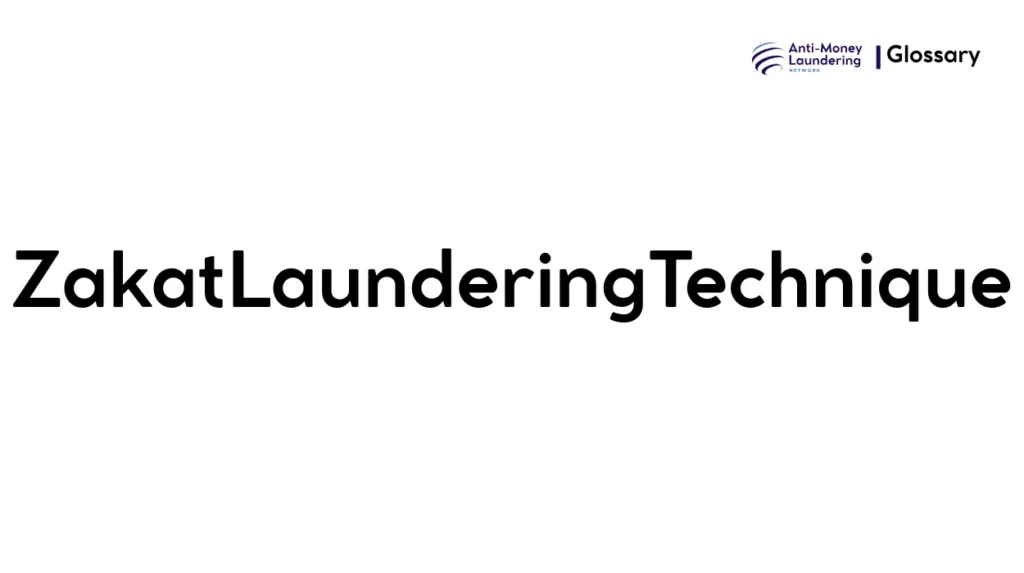Definition
ZakatLaunderingTechnique refers to the misuse or manipulation of Zakat, the Islamic obligatory almsgiving, as a method to launder illicit funds and evade anti-money laundering (AML) controls. It involves disguising the origins of unlawful proceeds by channeling them through Zakat payments, charities, or religious financial channels, thereby providing an appearance of legitimacy. This technique exploits the religious and social norms surrounding Zakat to shield dirty money from detection and to facilitate money laundering or financing of terrorism.
Purpose and Regulatory Basis
Role in AML
ZakatLaunderingTechnique represents a critical AML challenge because Zakat transactions often involve sizable financial flows within Islamic communities and institutions. Criminals exploit these transactions to integrate illicit proceeds into the legitimate financial system under the guise of religious giving. Recognizing and preventing this technique is essential to preserving the integrity of financial systems and ensuring compliance with global AML standards.
Why It Matters
Financial institutions, charitable organizations, and regulatory bodies must understand and mitigate risks of Zakat-based laundering to close loopholes in AML frameworks. Without controls targeting these avenues, Zakat payments can be manipulated to launder money or support terrorist financing.
Key Global/National Regulations
- Financial Action Task Force (FATF): Emphasizes regulating charities and nonprofit organizations, highlighting their vulnerability to abuse.
- USA PATRIOT Act: Mandates due diligence and monitoring of charitable giving and religious funds to prevent misuse.
- European Union Anti-Money Laundering Directives (AMLD): Require transparency and controls on charitable transactions including Zakat funds.
When and How it Applies
Real-World Use Cases
- Illicit actors donating large, frequent Zakat payments inconsistent with donor profiles.
- Zakat funds transferred via informal channels lacking transparency.
- Use of charitable organizations to funnel proceeds from illegal activities such as drug trafficking or corruption.
Triggers and Examples
- Unusual patterns in Zakat payments such as round figures, rapid transfers, or payments from high-risk jurisdictions.
- Lack of documentation or suspicious explanations for Zakat amounts.
Types or Variants
Variants Based on Method
- Direct Laundering: Illicit funds directly earmarked as Zakat payments to escape scrutiny.
- Sheltering Through Charities: Using charitable entities as intermediaries to mask the true origin of funds.
- Layering via Religious Channels: Complex transactions involving multiple religious or financial institutions to obscure trails.
Procedures and Implementation
Steps for Institutions
- Risk Assessment: Identify risks related to Zakat transactions and donors.
- Know Your Customer (KYC)/Customer Due Diligence (CDD): Verify identities and source of funds for Zakat payers.
- Transaction Monitoring: Use systems to detect unusual patterns or anomalies in Zakat payments.
- Enhanced Due Diligence (EDD): Apply for transactions flagged as high risk.
- Training: Educate staff on recognizing laundering tactics involving Zakat.
- Documentation: Maintain transparent records of Zakat collection and disbursement.
Systems, Controls, and Processes
- Integration of AML technologies such as transaction monitoring software tailored to recognize religious giving patterns.
- Sanctions screening against blacklists.
- Collaboration with Zakat authorities and religious entities for transparency.
Impact on Customers/Clients
- Customers may be subject to enhanced scrutiny when making Zakat payments.
- Rights to privacy balanced against AML obligations.
- Possible temporary restrictions or requests for additional documentation to verify legitimacy.
Duration, Review, and Resolution
- Continuous monitoring of Zakat-related transactions.
- Periodic reviews of controls and risk profiles.
- Prompt investigation and resolution of suspicious activity reports (SARs) linked to Zakat.
Reporting and Compliance Duties
- Mandatory filing of SARs to financial intelligence units when suspicious Zakat transactions are detected.
- Regular audits and independent testing of AML programs regarding Zakat.
- Potential penalties for non-compliance include fines, reputational damage, and legal action.
Related AML Terms
- ZakatCompliance: Ensuring Zakat processes align with AML rules to prevent misuse.
- ZakatSheltering: A specific act of disguising illicit funds under the cover of Zakat payments.
- Customer Due Diligence (CDD): Crucial for verifying Zakat payment sources.
- Transaction Monitoring: Identifies suspicious Zakat activity.
Challenges and Best Practices
Common Challenges
- Balancing respect for religious practices with rigorous AML enforcement.
- Lack of standardized reporting and disclosure frameworks for Zakat.
- Limited awareness among institutions about religious financial nuances.
Best Practices
- Collaborate closely with Islamic scholars and Zakat authorities for culturally sensitive AML approaches.
- Use technology and data analytics to identify red flags.
- Continuous staff training and updating policies to address evolving Zakat laundering risks.
Recent Developments
- Increased use of AI and machine learning to detect suspicious patterns in religious giving.
- Enhanced global regulatory focus on charitable giving as a laundering vector.
- Growing harmonization of national AML laws with FATF guidelines related to religious donations.
ZakatLaunderingTechnique is a sophisticated method that exploits obligatory Islamic almsgiving to launder illicit funds, posing compliance risks for financial institutions and charities. Understanding its mechanisms, regulatory basis, and detection methods is crucial for effective AML compliance and safeguarding the financial system’s integrity. Through robust risk assessments, monitoring, reporting, and collaboration with religious authorities, institutions can mitigate risks and uphold both AML standards and religious obligations.

